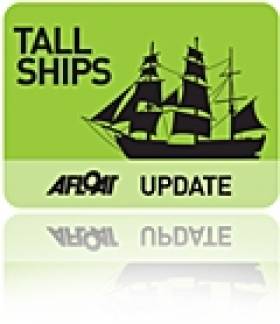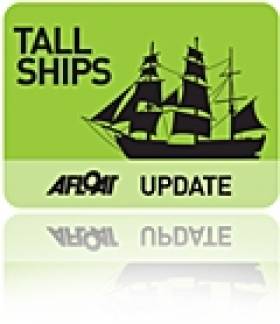Displaying items by tag: RaceLeg
Lord Nelson Heads for Waterford
As the Tall Ship STS Lord Nelson nears Carnsore Point off Wexford this evening the barque will be one of the many vessels participating in the Waterford Talls Ships Races Festival, writes Jehan Ashmore.
Joining Lord Nelson are three other UK entrants, they are the Jean de la Lune, Pelican of London and Royalist now celebrating her 40th anniversary. Together these tallships belong to the 'A' class vessels, the largest of the tallships. The impressive array of A class vessels includes four ships alone from The Netherlands with the Astrid, Eendracht, Europa and Wylde Swan, a schooner built in 1920.
From Norway is the fully rigged tallship Christian Radich and Sorlandet. The Poles are coming with their Pogoria. Neighbouring Russia are sending their impressive 108m long Mir which has 26 sails and has a 200-strong crew though the 1987 built vessel can be sailed with just 30. The final A class entrant is from outside Europe, the Columbian 1,300 tonnes Gloria, a three-master of over 60 metres long.
In addition to this exciting line-up are the 'B' and 'C' class which in total brings 45 tallships of all shapes and sizes to the quays of the River Suir. The crystal city will be host to over 1,000 trainess and over 400 professional crew who will take part in the colourful 'Crew Parade' held on Friday. For a full list of tallships and accompanying photos go to www.waterfordtallshipsrace.ie/the-race/the-tall-ships/
The spectacle of the festival will culminate in the early hours of Sunday when the fleet departs the city and heads downriver with a 'Parade of Sail' in the estuary of Waterford Harbour. As the tallships pass offshore of Dunmore East, this will mark the start of the first race-leg to Greenock.
The famous race is organised by Sail Training International (STI) a charity established to harness sail training to develop and educate young people, regardless of nationality, culture, religion, gender or social background.
The STI can trace its roots with the creation of the Sail Training International Race Committee which organised the first race of sail training tall ships in 1956. Their website is www.sailtraininginternational.org/
'Ferry' to Headline Waterford Tall Ships
Looking ahead to the Waterford show, Bryan Ferry said,' I am delighted to be returning to perform in Ireland following Roxy Music's performance at
Electric Picnic last year'.
Ferry will perform on the festival's main stage at Bolton Street. On the same site of the following night, The Waterboys will be supported by Waterford's O Emperor. While on the 2 July the headline act will be the Sharon Shannon Show with special guests Damien Dempsey and Dessie O'Halloran.
The four-day maritime spectacle which runs to 3 July is set to host over 70 tallships, over 1,500 trainee sailors and an anticipated 500,000 visitors that are to throng the 'Noblest Quays in Europe' with the countdown to the festival edging closer to just 100 days.
Billed as the largest Irish festival event in 2011, the return of the Tall Ships for the second time to Ireland's oldest city, presents young Irish people to experience a once in a lifetime opportunity to set sail onboard a tall-ship.
The opportunity is open to those aged 16 or over by June 30, 2011 and are fit and active to be a trainee on the inaugural race leg from Waterford to Greenock (departing 3 July). For further information click here.
The festival is not just eagerly awaited by fans of all things maritime and musical but with a programme that is also to feature street theatre, culinary and craftwork 'villages' and firework displays.
Renowned street theatre company 'Spraoi' have commissioned almost 20 national and international street performance acts. In addition the award-winning illusionist, Keith Barry will perform another specially-commissioned piece at the launch on the afternoon of 30 June.
On the nautical front, highlights include the 'Crew Parade' on 1 July and ultimately culminating with the 'Parade of Sail' by the international fleet on 3 July. Asides the city quayside on the River Suir the Waterford estuary provides excellent viewing points, some at elevated sites.
Looking for further reading on Tall Ships in Ireland? Click the links below:
Click this link to read all our Tall Ships Stories on one handy page
Previewing Ireland's Tall Ships 2011 Season
Can Ireland Get a New Tall Ship?
- street theatre
- Waterford Estuary
- River Suir
- Ports and Shipping News
- The Waterboys
- Keith Barry
- Bryan Ferry
- Roxy Music
- Waterford Tall Ships Race Festival
- TallShips
- Electic Picnic
- Sharron Shannon
- Spraoi
- Crew Parade
- Parade of Sail
- SailTrainees
- Damien Dempsey
- Dessie O'Halloran
- Noblest Quays in Europe
- RaceLeg
- WaterfordGreenock






























































